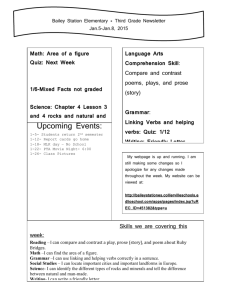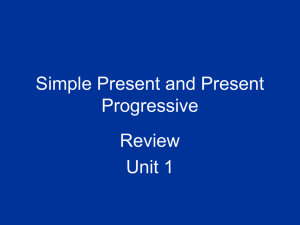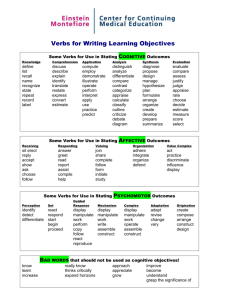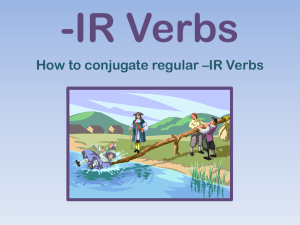二、汉英句法基本差异
advertisement
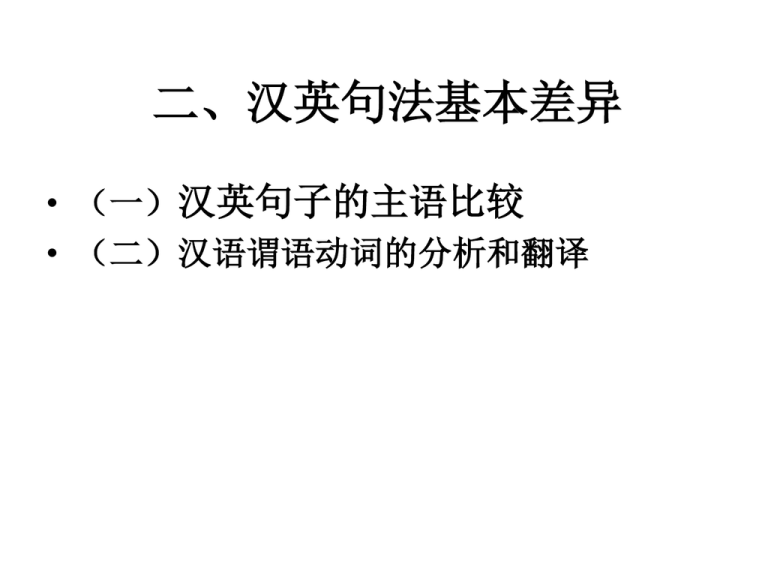
二、汉英句法基本差异 • (一)汉英句子的主语比较 • (二)汉语谓语动词的分析和翻译 • (一)汉英句子的主语比较 • 第一、主语的基本功能汉英有别 • 就句法结构而言,英语的主语显然是很重 要的句子成分。在翻译中,如何选择、如 何处理主语,至关紧要。 • 英语主语的功能要点: • 1. 在大多数情况下,英语主语具有“不可 或缺性” (indispensability); • 2.英语主语与谓语关系极其密切。由于主语 决定动词的数,实际上也就决定了它与动 词谓语的形态和数的一致(concord) ,由此 而构成了SV搭配。 • 汉语的主语: • 1.汉语的主语没有英语主语那么重要“不可 或缺”,汉语的句子常常是“非主谓句” (Non-SP Sentence) 。如: • A. 实在太荒唐。 • (不是“这实在太荒唐”的省略句,因为 “实在太荒唐”不一定指“这”) • It’s utterly absurd. • • • • • B.是我不好。 (不是“我是不好”的倒装) It’s my fault. C.热得我满头大汗。 (“热”指客观原因;这个句子不是“我 热得……”倒装, “我热得”指主观感受) • I’m all in a sweat. • 第二、TC优势与SV优势 • 汉语主语的一个非常重要的特征就是它的 “话题性”,汉语是话题型主语占优势的 语言。 • 英语句子基本上围绕主语与动词谓语的SV 搭配形成句子主轴或核心。 • 第三、汉英主语的词性比较 • 汉语的主语不限于名词,任何词均可作主 语,主语具有周遍性;而英语的主语必须 具有名词性。例如: 1. 动词主语 • 蹦蹦跳跳有助消化。(TC/TR) • (cf. Jumping and running help your digestion.) • 2. 修饰语(定语)主语 • 干干净净使人爱。 (TC/TR) • (cf. Everybody loves clean things.) • 3. 状语(方式)主语 • 这么快就盖好了一栋房子。(TC/TR) • (cf. The house was built at admirable speed.) • • • • • 5. 复合主语(主谓、述宾、述补、偏正) 水涨船高。(主谓词组) (cf. The ship rises with the tide.) 要有计划才好办事。(述宾词组) (cf. A good plan is necessary for doing business.) • 计算得快当然是个好条件。(述补词组) • (cf. The ability to do quick calculation is of course an advantage.) • 简单粗暴地干下去只会把事情搞糟。偏正 • (cf. It ruins the whole thing if you do it in a plash-dash way.) • • • • • • 6.带“的”字的名词词组主语 学得最好的有奖。(SVO) cf. The best learner will be given a reward. 7. 零位主语 又下雨了。(无主句) cf. It’s raining again. • 第四、汉译英中主语的选择 • 汉语在表达思想时,往往突出主题而 忽略主语,但英语的主语却是最主要的成份, 它对句子结构以及词语的选择起着决定性 的作用。 • 王力先生: • “就句子结构而论,西洋语言是法治的, 中国语言是人治的。法治的不管主语用得 着用不着,总要呆板地求句子形式的一律,人 治的用得着就用,用不着就不用,只要能使人 听懂说话人的意思,就算了。” • 因此,在汉译英时,确定用什么充当句 子的主语是一个首要的问题。 • 可以这么说,在汉译英时主语一旦确定, 句子翻译也就有眉目了。 • 请注意以下几个方面: • 一、中国历来有“天人合一”的观点,所以 汉语句子习惯用人来作主语。 • 英美人则较强调客观,因此英语句子的 主语是从事物出发,把“人”放在从属地位, 这也反映了中国人与 西方人思维方式的差 异。 • 请看例句: • 1.又过了几个月,我看见他们手上戴了结婚 戒指。可是他们不像以前那样健谈了,她 又在看书,他在看报。 • (胡文:《爱情故事》) • Months later, rings appeared glistening on their fingers but chatting became fewer for it was replaced by reading, one with a book and the other a newspaper. • 2.沉默了很长时间的丈夫,突然说出这样的 话来,而且在声音中还带着一丝藏不住的伤 感。(张振敏《珍惜感情》) • 汉语:“人—动作—情绪” • A tinge of melancholy was tangible in my husband's voice which broke the long silence. • 英语:“情绪—(人的)声音 —动作。” • 二、在汉译英中有些汉语句子的主语不显著或省 略,但译成英语时必须将主语确定并补译。 • 1. 在历史上,由于长江不断改道,在武汉地区形成 了众多的湖泊。 (主语不显著 ) • The constant change of the course of the Changjiang River in history helped form a great many lakes in the area around Wuhan. • 2.弄得不好,就会前功尽弃。 • (省略主语,译文必须根据上下文选用适当的 词补出主语) • 请试译: • A. If things are not properly handled, our labour will be totally lost. • B. If things go wrong, our efforts would be in vain. • 三、用时间或地点等名词作主语是英语中 较常见的现象,在汉译英中把主语定为时间 和地点,更符合西方人的思维模式和英语表 达习惯。 • 1.中国在1980年成功地发射了第一颗洲际 导弹。 • 1980 saw the successful launching of China's first intercontinental guided missile. • 请试译: • 2. 在南京城发生过许多重大的历史事件。 • 3. 2008北京奥运会的成功举办,让世人举目。 • Nanjing witnessed many great historic events. • The world witnessed the great success of the Olympic Games in Beijing 2008. • 析:译文以地点为主语,符合英语的表达习惯。 • 四、汉语中有很多无主句,而英语句子中主 语不可缺少,当译者无法找到合适的词作主 语时,应想到it形式主语和“there+be+主语” 结构。 • 1.下倾盆大雨了。 • It is raining cats and dogs. • 2.从来没想到他是个败家子。 • It never occurred to us that he was the black sheep of his family. • • • • • (二)汉语谓语动词的分析和翻译 第一、汉语谓语动词结构分析 1. 连动式谓语 (Seriate Verbs) 2. 兼语式谓语(Pivotal Verbs) 3. 紧缩式谓语(Contracted verb pattern) • • • • • 第二、汉语谓语动词形式与翻译 1. “连动式”谓语 (Seriate Verbs) ①并列式 ②从属式 ③链式 • ①并列式的形式及英译 • V1(O1 or X1)+ V2 (O2 or X2)两个动词表示 先后关系或同时关系。 • 常译成两个英语动词,用and连接,或将其 中比较次要的译作英语中的现在分词(作伴 随状态)。 • A. 我悄悄地披了大衫,带上门出去了。 • Shrugging on an overcoat, I made my way out, closing the door behind me. • B. 他的朋友阻止道:“不可性急。” • His friend checked him and said: “Hold your horse.” • • • • • • C.会客赴宴: V1(O1)+ V2(O2) receive visitors and attend dinner parties D.脱了鞋进屋: V1(O1)+ V2(O2) take off shoes and enter the room E.敲锣打鼓: V1(O1)+ V2(O2) beat drums and strike gongs • 注意:看似并列的连动在汉英转换中却不 能机械地以and连接。 • ①作词类分析: • 来龙去脉 • (“来、去”在词组中都是修饰语,不是 动词) • beginning and end • ( origin and evolution) • • • • • 请试译: 披头散发 穿针引线 ②作结构分析: 很多并列式连动只是一种离合式复迭,不 能用and去连接前后两个词组。 • • • • • 披头散发 (wear one’s hair loose) 穿针引线 (act as a go-between) (be a match-maker) • ②从属式的形式及英译 • V1(O1 or X1)→V2 (O2 or X2),几个动词 有主次之分,主要动词与次要动词之间有 逻辑联接关系。 • 英译时,一般将主要动词译英语的谓语动 词,将其它动词译作不定式、分词、介词 (短语)等。 • • • • 例如: A. 那晚天黑得伸手不见五指。 (条件结果) The night was so dark that you could hardly see your hand in front of your face. • B. 我们必须以高度的历史责任感和时代紧 迫感,继续集中力量进行经济建设,进一 步发展和壮大自己。(目的) • With a high sense of responsibility for the nation and the people and awareness of urgency, we will concentrate on economic construction in the hope of further strengthening and developing the nation. • C. 她1933年到上海定居,在那里,她的创 作进入了一个新的高潮期。(处所) • She settled in Shanghai in 1933, where her literary creation entered another period of flourishing. • • • • • • 干完就走 (条件关系) go as soon as/until the job is done 替谁干活 (对象关系) do the job for whom 屈膝求饶 (方式关系) beg for mercy on one’s knees • • • • • • 立等可取 (时间关系) ready while you wait 烤火取暖 (目的/方式关系) warm oneself by the fire 关门捉贼 keep the door closed to catch the thief • ③链式的形式及英译 • S V1(O1 or X1)V2(O2 or X2)…Vn(On or Xn) 是两个以上有次序或逻辑关系的主谓结构并列组 成,是比较复杂的并列式或从属式连动式。 英译时,表示动作先后可用and表达;表示从属关 系时,应仔细辨别各动词之间的关系,找出主要 动词,并根据目的语习惯进行翻译。 如: • A.他请假坐飞机回家探亲了。 • He asked for leave to go home by air to see his family. • B.这个犯罪团伙持枪劫车杀人越货,真是 罪大莫及。 • This band of criminals has hijacked trucks and looted the goods by killing drivers with guns. Even death cannot atone for their sins. • 2. 兼语式的结构与英译 • 兼语式的基本结构是S1V1(O1=S2)V2(O2) , 如:我们派他做代表。 • ⑴英译时常将兼语式中的第二个动词译作英 语的宾语补足语(用不定式、介词短语、形 容词、分词或名词来充当)。 • A.近几年中国政府一直鼓励外商参与重点经 济建设项目和现有企业的技术改造。 • In recent years China has been encouraging foreign businessmen to actively participate in China’s construction projects and the technological transformation of some existing enterprises. • B. 当局要求灾区群众开展生产自救,重建 家园。 • The authorities urged the people in the flood-stricken areas to overcome the adversity through greater production and to rebuild their own homes. • C. 国际社会呼吁交战双方早日达成停火协 议。 • The international community appealed to the warring sides for an earliest possible cease-fire agreement. • ⑵ 利用英语中表示“致使”、“促成”意 义的动词,翻译汉语兼语式谓语。例如: • A. 经济的腾飞使中国在国际事务中发挥着 越来越重要的作用。 • The booming economy enables China to play a more and more important role in the world affairs. • B. 她优美的歌声令听众如醉如痴。 • The singer’s beautiful voice enraptured the audience. • C. 这些项目具有技术起点高、经济效益好、 市场潜力大、发展后劲足等特点,能够使 投资者获得可观的效益。 • With a solid technical basis, sound economic efficiency, great market potential and bright prospective, these projects will secure good economic results for the investors. • ⑶ 兼语式的第一个动词为“表扬”、“称 赞”、“埋怨”、“责怪”、“批评”等 时,往往可将第二个动词译成英语中表示 原因的短语或从句。 • A. 那位评论家指责该书作者有剽窃行为。 • The critic criticized the author of the book for plagiarism. • B. 联合国粮农组织的高级官员在世界粮食 大会上盛赞中国致力于解决十二亿人中的 温饱问题。 • At the World Food Conference, senior officials from the UNFAO highly praised China for its endeavors in solving the problem of feeding and clothing its 1.2 billion population. • ⑷ 很多情况下,兼语式的英译需根据上下 文和英语习惯灵活处理。 • A. 我劝你还是投案自首,以求宽大处理。 • You’d better surrender yourself to the police in the hope of being accorded lenient treatment. • B. 当局禁止该影片上映。 • The film came under the ban of censor. • ⑸ 注意辨别兼语式。许多表层结构很像兼 语式样的结构,其实不是兼语式。例如: • A. 找份报纸看看。 • I want to read a newspaper. • B. 我记得他来过这里。 • I remember that he had come here. • 3.紧缩式(contracted verb pattern):这种 结构往往可以补入很多被紧缩掉的成分。 • 常根据上下文和英语表达习惯灵活处理。 • 如: • A.吃点药祛寒退热。 • You’ll be all right after taking some medicine to bring down your fever. • B.爱去不去。 • I don’t mind whether you go or not. • C.你许下的诺言非信守不可。(关联词) • It’s a promise you made. You ought to keep it. • D.对这种人还是以礼相待为好。 • To this kind of people, try to be civil and polite. • E.一吃药就吐。 • spew out whatever medicine on takes • • • • • • • 请翻译下列句子 1. 地震使这座城市变成了废墟。 2. 我们将随时让你知道情况。 3. 几乎所有的人都希望他倒霉。 4. 他们谴责他的和平努力是背叛。 5. 她老是批评她的丈夫马虎邋遢。 6. 老师表扬她乐于助人 • • • • • • 1. 那次地震使这座城市变成了废墟。 That earthquake reduced the city to ruins. 2. 我们将随时让你知道实情。 We will keep you well informed. 3. 几乎所有的人都希望他倒霉。 Almost everyone wish him ill. • 4. 他们谴责他的和平努力是背叛。 • They condemned his peace efforts as betrayal. • 5. 她老是批评她的丈夫马虎邋遢。 • She is always criticizing his husband for being sloppy. • 6. 老师表扬她乐于助人。 • The teacher praised her because she is always ready to help.



